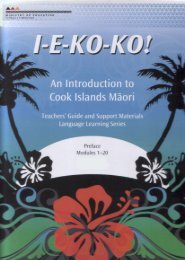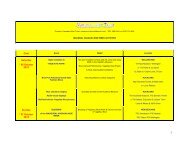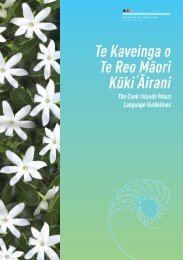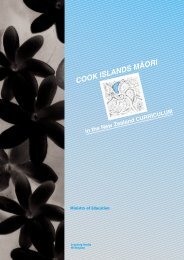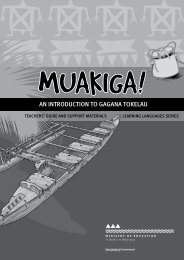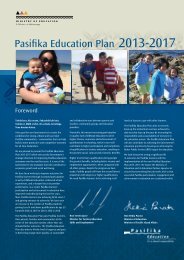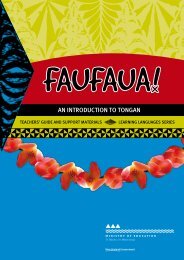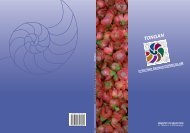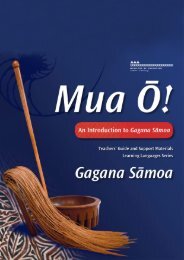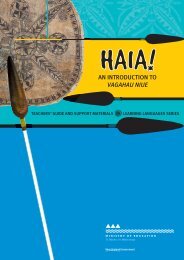Ta'iala mo le Gagana SÄmoa - Pasifika Education Community
Ta'iala mo le Gagana SÄmoa - Pasifika Education Community
Ta'iala mo le Gagana SÄmoa - Pasifika Education Community
Create successful ePaper yourself
Turn your PDF publications into a flip-book with our unique Google optimized e-Paper software.
Atamai i <strong>le</strong> Aganu‘uCultural Know<strong>le</strong>dgeStudents will:‘O ni fa‘ata‘ita‘iga i <strong>le</strong> aganu‘u fa‘asā<strong>mo</strong>aSuggested aspects of fa‘asā<strong>mo</strong>aStudents could be <strong>le</strong>arning through experiences thatallow them to:• experience and respond to gagana Sā<strong>mo</strong>a texts; • engage with texts that include poems (solo,tauloto, song lyrics), myths and <strong>le</strong>gends (forexamp<strong>le</strong>, ‘Apa‘ula and Vaea or Alo ma <strong>le</strong> Tanifa),songs (for examp<strong>le</strong>, “Le Lavalava”), and storiessuch as those in the Tupu series;• make connections with known culture(s). • compare everyday cultural practices, for examp<strong>le</strong>,ways of showing respect in Tongan, Māori, andother languages;• compare food practices, such as making an umu orhāngi, serving food, and seating peop<strong>le</strong> for a meal.Vāega 2: ‘O ni fa‘ata‘ita‘iga i <strong>le</strong> fa‘atinoga o a‘oa‘oga ma iloilogaLevel 2: Suggested <strong>le</strong>arning and assessment activities58Not all of the following activities are suitab<strong>le</strong> for every age group. Teachers will se<strong>le</strong>ct those that areappropriate, adjust a particular activity to suit the needs of their students, or make up their ownactivity appropriate to the objectives to be met. Some activities specific to cultural <strong>le</strong>arning are listedabove under the heading Suggested aspects of fa‘asā<strong>mo</strong>a. It is also important to acknow<strong>le</strong>dge thecultural context present in all genuinely communicative activities, so that students are supported asthey acquire the linguistic and the cultural know<strong>le</strong>dge and skills they need to communicate confidentlyand effectively with other speakers of gagana Sā<strong>mo</strong>a.<strong>Gagana</strong> fa‘alogo ma <strong>le</strong> tautalaOral language: Listening and speakingStudents could be <strong>le</strong>arning through:• talking to each other about their family relationships;• drawing weather symbols on a map to match the weather conditions described in a weather report;• using reinforcement strategies, for examp<strong>le</strong>, standing in a circ<strong>le</strong> holding pictures of clock faces thateach show a different time – the first student asks a second “Ua tā se fia?” and the second studentresponds, giving the time shown on their clock, the second student then asks the third student thesame question, and so on round the circ<strong>le</strong>;• ro<strong>le</strong>-playing an interview in which a prominent community member or ce<strong>le</strong>brity talks aboutthemselves;• creating pictures on the basis of descriptions;• listening to a conversation about peop<strong>le</strong> and families and answering questions to de<strong>mo</strong>nstratetheir <strong>le</strong>vel of understanding;• placing items in the correct sequence according to spoken instructions;• drawing the hands on clock faces according to a time the teacher gives, or stating the timesshown on comp<strong>le</strong>ted clock faces;



